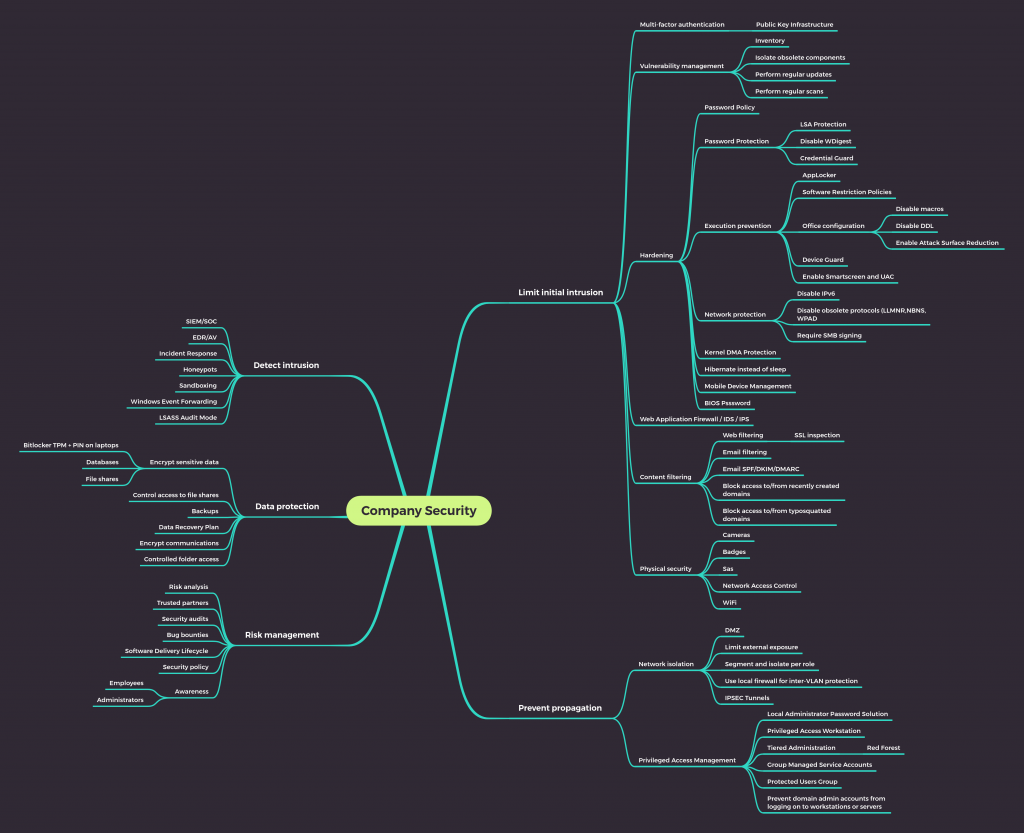During the first wave of Covid and most people locked up at home, I wanted to engage with my colleagues in various departments here at SCRT by having them answer a simple survey. The survey related to what actions they would recommend and prioritize in order to secure the information system of a random company, which had just received notification that a cyberattack was imminent.
The survey
Everybody was asked to provide up to 10 recommendations and my initial goal was to see whether there was a consensus between our different teams. For example, I wanted to make sure that our sales team would provide similar answers to our engineering teams.
In any case, I wanted to keep the answers as open as possible, which made it a little harder to parse the results, since some of my colleagues gave some very creative answers. One such example were the recommendations of writing a book on how to obtain a magical budget, followed by a sequel on how to spend that budget with SCRT. Needless to say, this was a bit of an outlier, but for other cases, I attempted to group similar answers into categories. For example, the two following recommendations “Install a good anti-virus solution on workstations” and “Setup EDR agents on all workstations and servers with machine learning capabilities such as Cortex XDR Pro” were eventually summarised as “EDR/AV”.
I had to make some choices as to what would be grouped together. I decided EDR and AV solutions could be considered as a similar recommendations, while I decided that “Updates” and “Vulnerability management” were going to remain separate. A number of answers were grouped into “Network isolation” which also explains some of the results I’ll give below.
After categorizing each one of the recommendations, I then attributed a weight from 1 to 10 to each of them depending on the priority given by the person.
Results
Without any further ado, here are the most frequently recommended actions (with their cumulated weight) out of the 33 colleagues who responded to my survey:
- Network isolation (173)
- Security patching (107)
- Configurations hardening (100)
- Limit external exposure (97)
- SIEM/SOC (95)
- Awareness training (95)
- Audit (89)
- Multi-factor authentication (87)
- Privileged access management (82)
- Backups (49)
- EDR/AV (45)
- LAPS (41)
- Robust password policy (40)
- DMZ (37)
- WAF (37)
[…] - Contact SCRT 😉 (22 points)
If we ignore the weights and just count the number of times each recommendation is given, we obtain the following results.
- Network isolation (25)
- SIEM/SOC (22)
- Audit (22)
- Security patching (20)
- Configurations hardening (20)
- Awareness training (15)
- Privileged access management (14)
- Multi-factor authentication (14)
- Limit external exposure (11)
- EDR/AV (9)
- Robust password policy (8)
- LAPS (7)
- Backups (7)
- Bitlocker (6)
- Physical access (5)
[…] - Contact SCRT 😉 (4)
Discussion
The differences are interesting to look at as they mean for example that most people recommended implementing a SIEM/SOC and performing an audit, but these were not considered as priorities.
I think it is important here to stress that when we mention “network isolation”, it goes beyond simple network segmentation. We are not talking about ensuring you have different VLANs for different types of systems, but actively enforcing appropriate firewalls between VLANs and within the same VLAN. It is this active firewalling which can prevent the exploitation of vulnerabilities in the first place and reduce the possibilities of lateral movement. While micro-segmentation and Zero Trust are valuable objectives, in the mean time, properly configuring the current firewalls has to be a priority.
When analysing the responses on a department level, it was interesting to see that our support team tends to recommend contacting SCRT and our analytics team recommends implementing a SIEM/SOC. Our pentesting team does not necessarily recommend performing an audit as a top priority, probably because we already anticipate what the findings are likely to be, which kind of skews the results. For our sales team though, performing an audit received the highest priority.
Wrapping things up
Based on the answers, I drew up a mindmap of actions that could be taken to improve the security of an information system. It contains more details than what is summarised in this blog post and the actions have been grouped by the following objectives:
- Prevent the initial intrusion
- Detect the intrusion
- Limit its propagation
- Protect/preserve sensitive data
- Manage risk

There is already quite a bit of information in here, though there is even more which is still missing, but it does give an overview of the higher priority aspects, which can be worked on to generally improve the security posture of a company.
